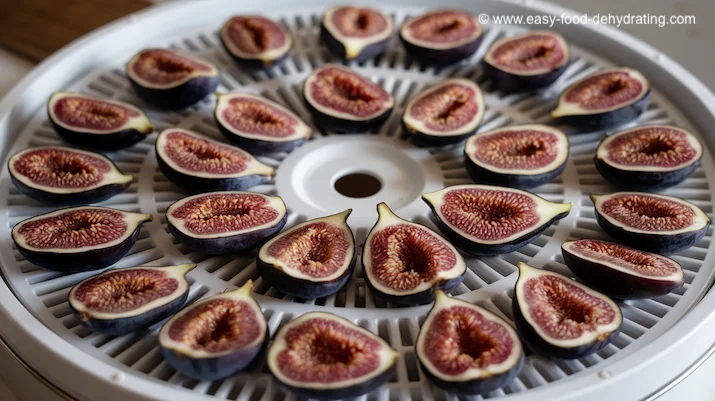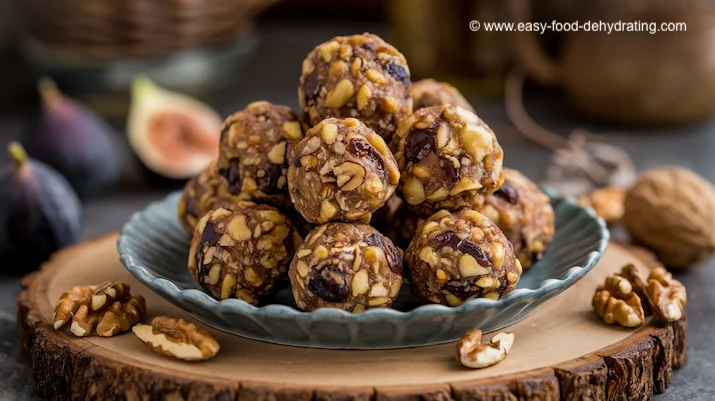What We Mean by “Dehydrate”
Here at Easy Food Dehydrating, “dehydrate” always means using an electric food dehydrator — the easy, reliable way to dry food at home.
- Home
- Dehydrating Fruits: Step-by-Step Guides by Type
- How to Dehydrate Figs: Easy Steps for Sweet & Long-Lasting Snacks
How to Dehydrate Figs:
Keep Them Sweet & Fresh for Months!

Figs are nature’s candy — sweet, soft, and packed with fiber and minerals. The only problem? They spoil quickly. Dehydrating figs is the easiest way to lock in their flavor and nutrition while giving you chewy, golden bites that last for months.
✅ Quick Answer: How do you dehydrate figs?
Wash and slice ripe figs, then place them cut-side up on dehydrator trays. Dry at 135–145°F (57–63°C) for 12–24 hours until leathery but pliable. Store completely cooled figs in airtight containers with oxygen absorbers to keep them fresh for up to a year.
Whether you want healthy snacks, baking add-ins, or recipe-ready ingredients, drying figs at home is simple and rewarding. Here’s exactly how to do it step by step.
And check out my Honey-Walnut-Fig Energy Balls recipe here!

Why Dehydrate Figs? (Sweetness + Shelf Life)
Figs are not only delicious but also packed with nutrients that make them a healthy addition to your pantry. Dehydrating these fruits preserves their sweetness and extends their shelf life, allowing you to enjoy them throughout the year.
Step-by-Step: How to Dehydrate Figs at Home
Drying figs is simple once you know the prep work and the right temperature settings. Follow these steps to get chewy, perfectly preserved figs every time.
- Choose & Prep Your Figs: Pick fresh, ripe figs that are slightly soft to the touch but not mushy. Overripe figs may ferment and taste sour, while under-ripe figs can be bitter. Wash them thoroughly under cool running water, pat dry, and remove stems. For faster, more even drying, slice figs in half lengthwise. Very large figs can be quartered.
- Arrange for Even Drying: Place the prepared figs cut-side up on dehydrator trays. Make sure pieces don’t overlap and leave space for air to circulate between them. This helps prevent uneven drying.
- Set the Right Temperature & Time: Dry figs at 135–145°F (57–63°C), following your dehydrator’s manual. Drying usually takes 12–24 hours, depending on fig size and juiciness. Start checking after the 12-hour mark, and rotate trays for even drying results.
- Test for Doneness: Properly dried figs should be leathery yet pliable. They shouldn’t feel sticky or tacky, but also shouldn’t be rock hard or brittle. Let them cool completely before storing to avoid condensation inside your containers.
💡 Tip: Outside the U.S.? Most dehydrating temps here are listed in Fahrenheit - use our quick converter to see the Celsius equivalent for your machine.
Are Dried Figs Healthy? Benefits You Should Know
Vitamins: Figs are rich in vitamins A, C, and K, as well as B-complex vitamins like B1 (Thiamine), B2 (Riboflavin), B3 (Niacin), and B6 (Pyridoxine).
Minerals: They contain potassium, calcium, magnesium, iron, copper, manganese, zinc, and phosphorus, supporting various bodily functions.
Fiber Content: Figs are a fantastic source of fiber, containing both soluble and insoluble fiber. This combination aids digestive health, promotes regularity, and helps maintain stable blood sugar levels.
Where Do Figs Grow? (Best Growing Regions)
Figs, those sweet and succulent fruits that have graced tables for millennia, thrive in Mediterranean climates. In the United States, California leads fig production, with the Central Valley serving as the heart of commercial fig farming.
Other notable growing regions include Texas, Florida, and parts of the Southeast, where the climate supports fig trees.
When Is Fig Season? (Best Times to Harvest)
The fig-picking season typically runs from June through September, with peak harvest occurring in late summer.
Some fig varieties even produce two crops per year.
The first crop, called "breba," arrives in early summer, while the main crop follows in late summer to early fall. The term "breba" originates from the Spanish word breva, meaning "early fig."
Best Storage Tips for Long-Lasting Dried Figs
Once the figs are dried, allow them to cool completely before storing them. This prevents condensation, which could lead to mold.
Smart Storage Tips: Keep Figs Fresh for Months
- For long-term storage, use food vacuum-sealer bags with oxygen absorbers to keep your dried figs fresh for up to a year.
- Alternatively, store them in airtight Mason jars with oxygen absorbers and place them in a cool, dark place.
Recipe Idea: Honey-Walnut-Fig Energy Balls
Put your dried figs to delicious use with this easy recipe for Honey-Walnut-Fig Energy Balls. Packed with nutrients and flavor, these energy balls make a great snack or on-the-go breakfast.
Click here to get the full recipe!
Final Thoughts: Why Drying Figs Is Worth the Effort
Dehydrating figs is one of the simplest ways to preserve their natural sweetness and enjoy them year-round — from snacking straight out of the jar to stirring into oatmeal or energy bites.
Fig Drying FAQs: Answers You’ll Actually Use
Now, let's address some frequently asked questions about dehydrating figs:
Do I need to peel figs before dehydrating them?
Do I need to peel figs before dehydrating them?
No, the skin is edible and nutritious. Simply wash them thoroughly before drying.
How can I tell if my dried figs have gone bad?
How can I tell if my dried figs have gone bad?
Check for mold, dark spots, or an unpleasant sour smell — fresh dried figs should smell sweet, not musty. Also look for condensation inside the storage container, as trapped moisture often leads to spoilage. If you notice any of these signs, discard the figs.Look for signs of mold, discoloration, or an off smell. If any of these are present, discard the figs.
Can I dry figs in the oven instead of a dehydrator?
Can I dry figs in the oven instead of a dehydrator?
Yes, set your oven to the lowest temperature, typically around 135°F, and follow the same steps. Leave the oven door slightly open to allow moisture to escape by using the handle of a wooden spoon to prop it open!
Should I soak dried figs before using them in recipes?
Should I soak dried figs before using them in recipes?
Soaking isn’t required, but it can plump figs back up and soften their texture for baking, sauces, or desserts. Simply cover them with warm water and let them sit for 10–15 minutes, then drain before using.
What's the best way to prevent dried figs from sticking together during storage?
What's the best way to prevent dried figs from sticking together during storage?
Make sure the figs are fully dried and cooled before storing — even a little leftover moisture can cause clumping. Store them in airtight containers with oxygen absorbers, layering parchment paper between pieces if needed. A light dusting of cornstarch also helps keep them separate.
And if you’d love even more inspiration, be sure to grab your free 5 Dried Food Recipes You'll Actually Love PDF below. Inside, you’ll find my go-to favorites like carrot soup, minestrone, split pea soup, spicy beef jerky, and banana cinnamon rolls — all made easy with dehydrated foods.
Get 5 Dried Food Recipes You'll Actually Love
Here's where you can get your copy of our all new
5 Dried Food Recipes (That Actually Taste Great)
They're my all-time favorite easy dried food meals!
Get it here right now.
For Free!
Before You Go...
If you enjoyed this page, tap the ❤️ in the lower right-hand corner.
It saves this page to your Grow bookmarks so you can find it again later.
You’ll also see quick share buttons to copy the link, post to Facebook,
or save it straight to Pinterest.

















